Jews’ Temporary Shelter Cards: A Snapshot
Since the beginning of 2022, Lewis has been working with the Jewish Museum London to help visualise the Jews’ Temporary Shelter (JTS) collection of cards.
Museums always tend to have the same problem – too much history, too little time and resources to tell it. Every box of records has something new to say, another pathway to follow, or a new story to unveil. This was the core of the thinking behind the new project ‘Mapping the Jewish Temporary Shelter’. This project focuses on a series of documents recorded by the JTS, in particular, the record cards produced for each person transferring through the shelter.
The JTS has a wide history, spanning from the late 19th Century and spanning well into the 21st. Alice Quine has already published a fantastic article on this, but in short, the Jews’ Temporary Shelter was set up in 1885 to help Jewish immigrants and refugees, often arriving with little but the clothes on their back, find their feet in London. Baker Samuel Cohen, also called Simcha the baker, had opened the unused parts of his bakery for any Jew in need of help. After temporarily shifting the shelter to Garden Street, the JTS found a more permanent premises at 84 Leman Street, London.[1]
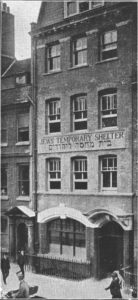
These cards, identified with little more than ‘Jews Temporary Shelter’ as a title, were intended to function as part of the bureaucracy of Jewish migrants. The cards recorded basic details such as an individual or family group name, birth place, age, trade and means, but also when an individual or family arrived, their reason for leaving home, destination and date of departure. These cards also recorded a series of ‘remarks’ acting as a space for record keepers to make notes of the particular circumstances of a case.
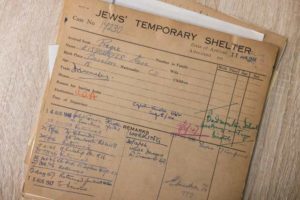
On the face of the problem, we have what appears to be a series of functional, relatively mundane items of bureaucracy. However, this could not be further from the reality – what was most exciting about this is that there are so many unanswered questions. Of course, we could say lots about individual JTS cards, but we knew very little about what kind of broad trends they represented – we had no idea what ages of people transferred, where from, where to, for how long, or indeed how many cards were here – this meant that every discovery is new! This project began with little foreknowledge about the trends in the JTS cards, and therefore the history that comes out is completely unique, never before studied.
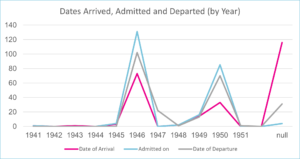
So what have we learned so far? Well, the records held in this collection represent movements through the Temporary Shelter between 1941 and 1951. There was a huge spike in admissions through the Shelter in 1946 and again in 1950.
We also know that it was primarily young people that transferred through the JTS – with a high proportion of young people between the age of 13 and 16. There were few individuals that transferred through the shelter over the age of 50, but this tended to be rarer.
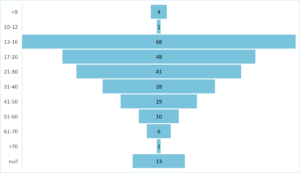
We also discovered that most of those transferring were from Czechoslovakia and Poland, and most transferred alone.
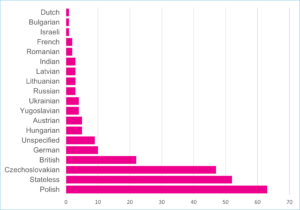
Perhaps most excitingly is the ‘arrived from’ and ‘destination’ columns: this gives us a start point, a transfer point (the JTS) and a destination – therefore, we can trace not just the movements of many of those who used the JTS across the world, but when they moved. There are many advantages to this, most important of all that searching data by location is easier for people interested in genealogical research. People remember approximate places better than specific details contained on the cards.
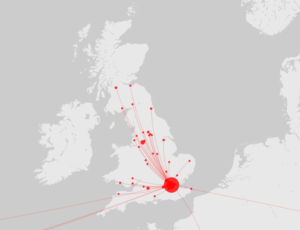
This insight can also help us go back down to the individual cards themselves. Now that we can see the broader history, we can identify individuals and families and trace their journeys across the world.
It is important to remember that these are only a handful of initial visualisations of the data – not conclusions. Over the next couple of months, this project will further assess and analyse this data and what we can do with it.
By Lewis Smith, Freelancer for the Jewish Museum London and Researcher at the University of Essex.
The JTS Cards Project, Mapping Migration, is supported by The Audience Agency’s Digitally Democratising Archives project thanks to funding from DCMS and the National Lottery, as part of The National Lottery Heritage Fund’s, Digital Skills for Heritage initiative.
![]()


[1] Klaus Weber (2013), Tobias Brinkmann (ed.), “The Jews’ Temporary Shelter in London, 1885–1939”, Points of Passage: Jewish Migrants from Eastern Europe in Scandinavia, Germany, and Britain 1880-1914, Berghahn Books, pp. 85–104.
[2] Created using the University of Stanford’s Palladio tool (https://hdlab.stanford.edu/palladio/)